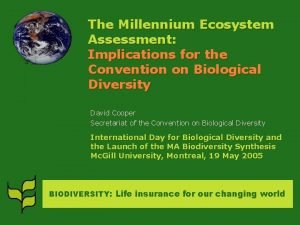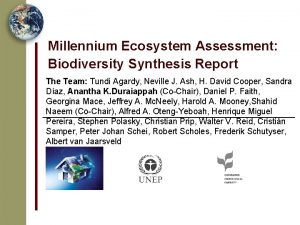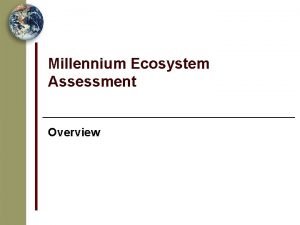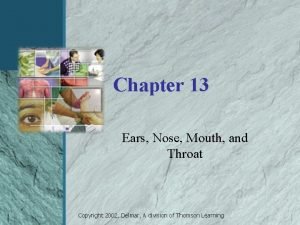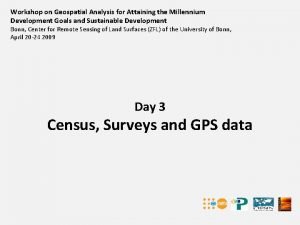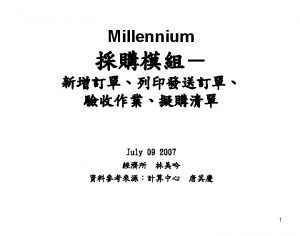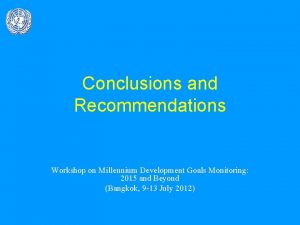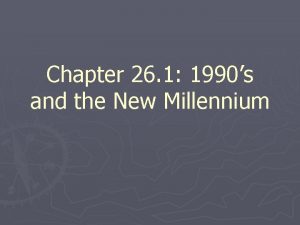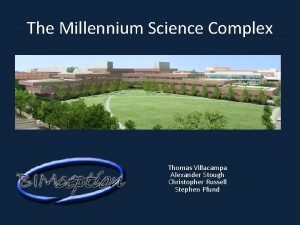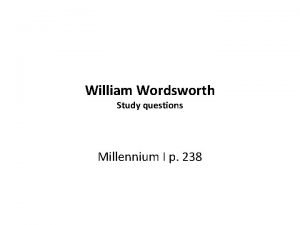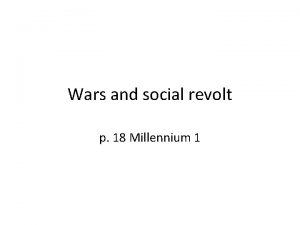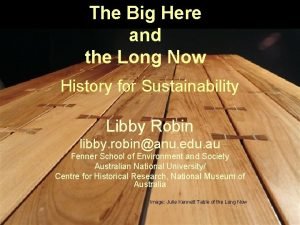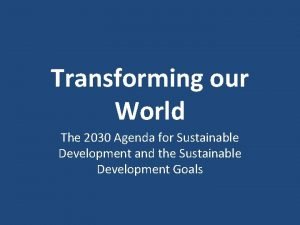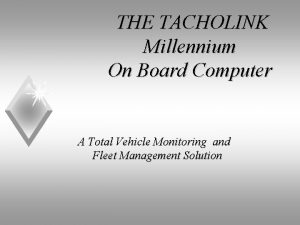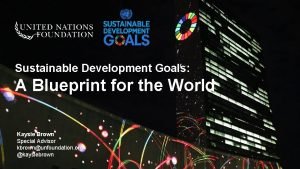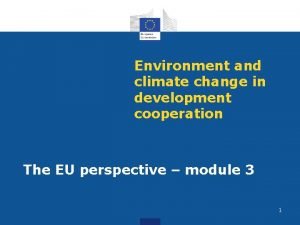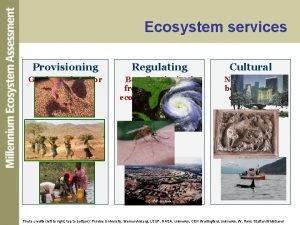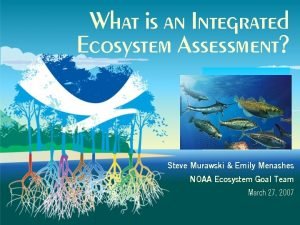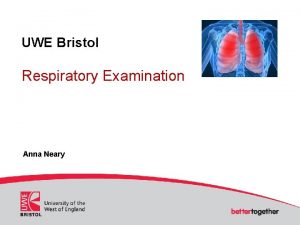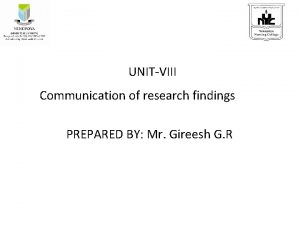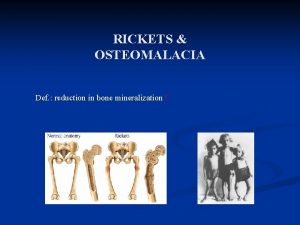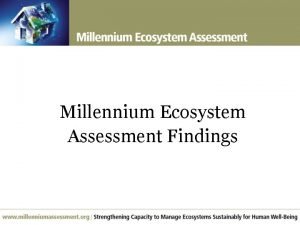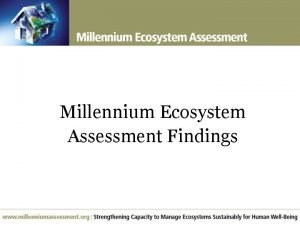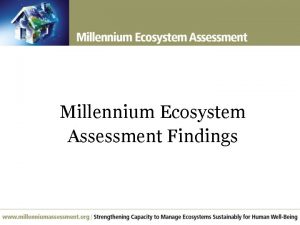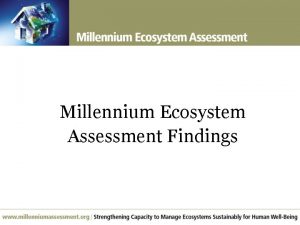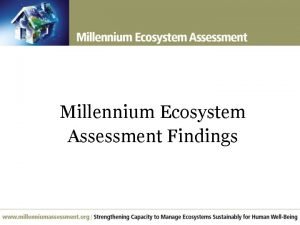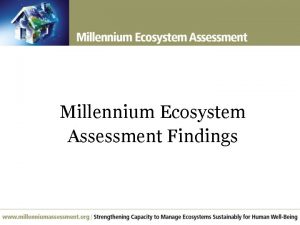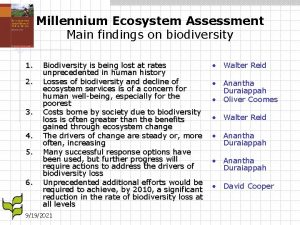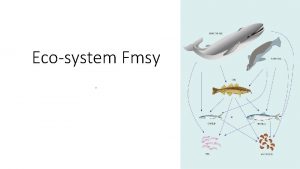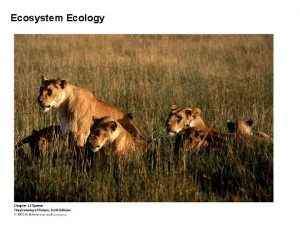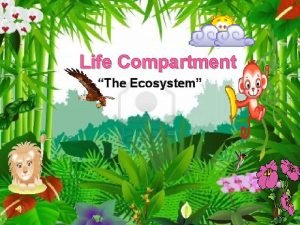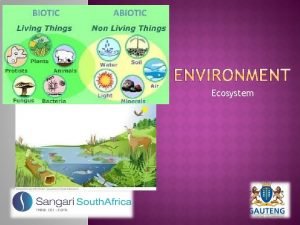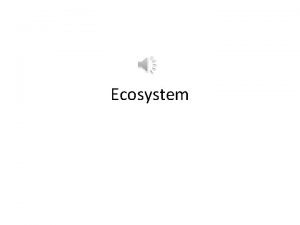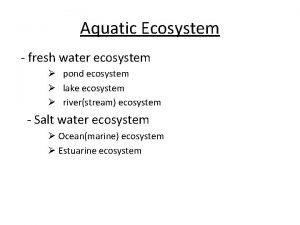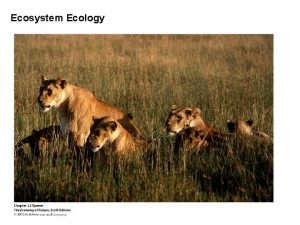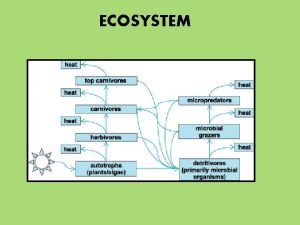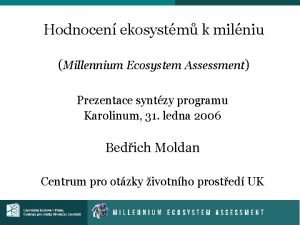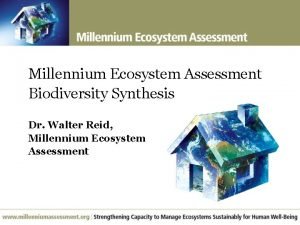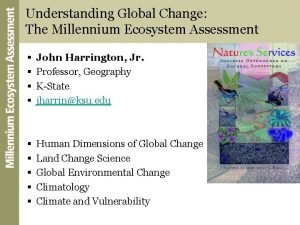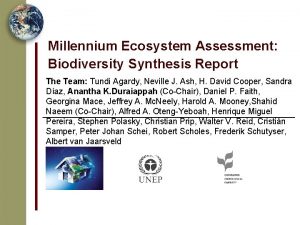Millennium Ecosystem Assessment Findings Largest assessment of the









































- Slides: 41

Millennium Ecosystem Assessment Findings

Largest assessment of the health of the planet’s ecosystems Experts and Review Process § § Prepared by 1360 experts from 95 countries 80 -person independent board of review editors Review comments from 850 experts and governments In addition to global assessment, includes information from 33 sub-global assessments Governance § Called for by UN Secretary General in 2000 § Authorized by governments through 4 conventions § Partnership of UN agencies, conventions, business, non-governmental organizations with a multistakeholder board of directors

Focus: Ecosystem Services The benefits people obtain from ecosystems

Focus: Consequences of Ecosystem Change for Human Well-being

MA Findings - Outline 1. Ecosystem Changes in Last 50 Years 2. Gains and Losses from Ecosystem Change Three major problems will decrease long-term benefits § § § Degradation of Ecosystem Services Increased Likelihood of Nonlinear Changes Exacerbation of Poverty for Some People 3. Ecosystem Prospects for Next 50 Years 4. Reversing Ecosystem Degradation

Finding #1 Over the past 50 years, humans have changed ecosystems more rapidly and extensively than in any comparable period of time in human history This has resulted in a substantial and largely irreversible loss in the diversity of life on Earth

Unprecedented change: Ecosystems • • • More land was converted to cropland since 1945 than in the 18 th and 19 th centuries combined 25% of the world’s coral reefs were badly degraded or destroyed in the last several decades 35% of mangrove area has been lost in this time Amount of water in reservoirs quadrupled since 1960 Withdrawals from rivers and lakes doubled since 1960

Unprecedented change: Biogeochemical Cycles Since 1960: § Flows of biologically available nitrogen in terrestrial ecosystems doubled § Flows of phosphorus tripled > 50% of all the synthetic nitrogen fertilizer ever used has been used since 1985 60% of the increase in the atmospheric concentration of CO 2 since 1750 has taken place since 1959 Human-produced Reactive Nitrogen Humans produce as much biologically available N as all natural pathways and this may grow a further 65% by 2050

Significant and largely irreversible changes to species diversity The distribution of species on Earth is becoming more homogenous Humans have increased the species extinction rate by between 50 and 1, 000 times over background rates typical over the planet’s history (medium certainty) 10– 30% of mammal, bird, and amphibian species are currently threatened with extinction (medium to high certainty)

MA Findings - Outline 1. Ecosystem Changes in Last 50 Years 2. Gains and Losses from Ecosystem Change Three major problems will decrease long-term benefits § § § Degradation of Ecosystem Services Increased Likelihood of Nonlinear Changes Exacerbation of Poverty for Some People 3. Ecosystem Prospects for Next 50 Years 4. Reversing Ecosystem Degradation

Finding #2 The changes that have been made to ecosystems have contributed to substantial net gains in human well-being and economic development, but these gains have been achieved at growing costs These problems will substantially diminish the benefits that future generations obtain from ecosystems.

Changes to ecosystems have provided substantial benefits Since 1960, while population doubled and economic activity increased 6 -fold: § food production increased 2 ½ times; food production per capita has grown and food price has fallen § water use doubled § wood harvests for pulp and paper production tripled § timber production increased by more than half § installed hydropower capacity doubled

MA Findings - Outline 1. Ecosystem Changes in Last 50 Years 2. Gains and Losses from Ecosystem Change Three major problems will decrease long-term benefits § § § Degradation of Ecosystem Services Increased Likelihood of Nonlinear Changes Exacerbation of Poverty for Some People 3. Ecosystem Prospects for Next 50 Years 4. Reversing Ecosystem Degradation

Degradation and unsustainable use of ecosystem services Approximately 60% (15 out of 24) of the ecosystem services evaluated in this assessment are being degraded or used unsustainably The degradation of ecosystem services often causes significant harm to human well-being and represents a loss of a natural asset or wealth of a country

Status of Provisioning Services Service Food Fiber Status crops livestock capture fisheries aquaculture wild foods timber +/– cotton, silk +/– wood fuel Genetic resources Biochemicals, medicines Water fresh water

Status of Regulating and Cultural Services Status Regulating Services Air quality regulation Climate regulation – global Climate regulation – regional and local Water regulation +/– Erosion regulation Water purification and waste treatment Disease regulation +/– Pest regulation Pollination Natural hazard regulation Cultural Services Spiritual and religious values Aesthetic values Recreation and ecotourism +/–

Degradation of ecosystem services often causes significant harm to human well-being The total economic value associated with managing ecosystems more sustainably is often higher than the value associated with conversion Conversion often still takes place because private economic benefits are often greater for the converted system

The degradation of ecosystem services represents loss of a capital asset Loss of wealth due to ecosystem degradation is not reflected in economic accounts § Ecosystem services, as well as resources such as mineral deposits, soil nutrients, and fossil fuels are capital assets § Traditional national accounts do not include measures of resource depletion or of the degradation of these resources § A country could cut its forests and deplete its fisheries, and this would show only as a positive gain in GDP without registering the corresponding decline in assets (wealth) § A number of countries that appeared to have positive growth in net savings (wealth) in 2001 actually experienced a loss in wealth when degradation of natural resources were factored into the accounts

MA Findings - Outline 1. Ecosystem Changes in Last 50 Years 2. Gains and Losses from Ecosystem Change Three major problems will decrease long-term benefits § § § Degradation of Ecosystem Services Increased Likelihood of Nonlinear Changes Exacerbation of Poverty for Some People 3. Ecosystem Prospects for Next 50 Years 4. Reversing Ecosystem Degradation

Increased likelihood of nonlinear changes There is established but incomplete evidence that changes being made in ecosystems are increasing the likelihood of nonlinear and potentially abrupt changes in ecosystems, with important consequences for human well-being

Examples of nonlinear change Fisheries collapse Eutrophication and hypoxia Disease emergence Species introductions and losses Regional climate change

MA Findings - Outline 1. Ecosystem Changes in Last 50 Years 2. Gains and Losses from Ecosystem Change Three major problems will decrease long-term benefits § § § Degradation of Ecosystem Services Increased Likelihood of Nonlinear Changes Exacerbation of Poverty for Some People 3. Ecosystem Prospects for Next 50 Years 4. Reversing Ecosystem Degradation

Level of poverty remains high and inequities are growing Economics and Human Development § 1. 1 billion people surviving on less than $1 per day of income. § During the 1990 s, 21 countries experienced declines in their rankings in the Human Development Index Access to Ecosystem Services § An estimated 856 million people were undernourished in 2000– 2002, up 32 million from 1995– 97 § Per capita food production has declined in sub-Saharan Africa § Some 1. 1 billion people still lack access to improved water supply, and more than 2. 6 billion lack access to improved sanitation § Water scarcity affects roughly 1– 2 billion people worldwide

Ecosystem services and poverty reduction Degradation of ecosystem services harms poor people § Half the urban population in Africa, Asia, Latin America, and the Caribbean suffers from one or more diseases associated with inadequate water and sanitation § The declining state of capture fisheries is reducing an inexpensive source of protein in developing countries. Per capita fish consumption in developing countries, excluding China, declined between 1985 and 1997 Pattern of winners and losers has not been taken into account in management decisions

Ecosystem services and poverty reduction Critical concern: Dryland systems § Lowest levels of human well-being § Only 8% of the world’s renewable water supply § Per capita water availability is two thirds of the level required for minimum levels of human well-being § Approximately 10– 20% of drylands are degraded § Experienced the highest population growth rate in the 1990 s § Cover 41% of Earth’s land surface and more than 2 billion people inhabit them

MA Findings - Outline 1. Ecosystem Changes in Last 50 Years 2. Gains and Losses from Ecosystem Change Three major problems will decrease long-term benefits § § § Degradation of Ecosystem Services Increased Likelihood of Nonlinear Changes Exacerbation of Poverty for Some People 3. Ecosystem Prospects for Next 50 Years 4. Reversing Ecosystem Degradation

Finding #3: The degradation of ecosystem services could grow significantly worse during the first half of this century and is a barrier to achieving the Millennium Development Goals

Direct drivers growing in intensity Most direct drivers of degradation in ecosystem services remain constant or are growing in intensity in most ecosystems

MA Scenarios Not predictions – scenarios are plausible futures Both quantitative models and qualitative analysis used in scenario development

Changes in direct drivers Habitat transformation: Further 10– 20% of grassland forestland is projected to be converted by 2050 Overexploitation, overfishing: Pressures continue to grow in all scenarios Invasive alien species: Spread continues to increase

Changes in direct drivers: Nutrient loading Humans have already doubled the flow of reactive nitrogen on the continents, and some projections suggest that this may increase by roughly a further two thirds by 2050. The MA scenarios project that the global flux of nitrogen to coastal ecosystems will increase by a further 10– 20% by 2030, with almost all of this increase occurring in developing countries.

Changes in direct drivers: Climate Change Potential future impacts § By the end of the century, climate change and its impacts may be the dominant direct driver of biodiversity loss and changes in ecosystem services globally Net harmful impact on ecosystem services § The balance of scientific evidence suggests that there will be a significant net harmful impact on ecosystem services worldwide if global mean surface temperature increases more than 2 o C above preindustrial levels (medium certainty)

Degradation of ecosystem services is a significant barrier to achievement of MDGs Regional concerns § Regions facing the greatest challenges in achieving the 2015 targets coincide with regions facing the greatest problems of ecosystem degradation: sub-Saharan Africa, Central Asia, parts of South and Southeast Asia, and some regions in Latin America Strong linkages with ecosystem condition § Although socioeconomic factors will play a primary role in achieving many of the MDGs, targets are unlikely to be met without improvement in ecosystem management for goals such as: · Poverty Reduction · Hunger · Disease · Environmental Sustainability including access to water

MA Findings - Outline 1. Ecosystem Changes in Last 50 Years 2. Gains and Losses from Ecosystem Change Three major problems will decrease long-term benefits § § § Degradation of Ecosystem Services Increased Likelihood of Nonlinear Changes Exacerbation of Poverty for Some People 3. Ecosystem Prospects for Next 50 Years 4. Reversing Ecosystem Degradation

Finding #4: The challenge of reversing the degradation of ecosystems while meeting increasing demands for their services can be met under some scenarios involving significant policy and institutional changes, but these changes are large and not currently under way Many options exist to conserve or enhance specific ecosystem services in ways that reduce negative tradeoffs or that provide positive synergies with other ecosystem services

Improvements in services can be achieved by 2050 Three of the four scenarios show that significant changes in policy can mitigate many of the negative consequences of growing pressures on ecosystems, although the changes required are large and not currently under way

Responses – Importance of Indirect Drivers Ecosystem degradation can rarely be reversed without actions that address one or more indirect drivers of change: § population change (including growth and migration) § change in economic activity (including economic growth, disparities in wealth, and trade patterns) § sociopolitical factors (including factors ranging from the presence of conflict to public participation in decision-making) § cultural factors § technological change Collectively these factors influence the level of production and consumption of ecosystem services and the sustainability of the production.

Promising Responses Institutions § Increased transparency and accountability of government and private-sector performance Economics § Elimination of subsidies that promote excessive use of ecosystem services (and, where possible, transfer these subsidies to payments for nonmarketed ecosystem services) § Greater use of economic instruments and market-based approaches in the management of ecosystem services (where enabling conditions exist):

Promising Responses Technology § Promotion of technologies that enable increased crop yields without harmful impacts § Restoration of ecosystem services Social and Behavioral § Changes in consumption § Communication and education § Empowerment of groups dependent on ecosystem services Knowledge § Incorporation of nonmarket values of ecosystems in resource management decisions § Enhancement of human and institutional capacity

Summary Over the past 50 years, humans have changed ecosystems more rapidly and extensively than in any comparable period of time in human history. The changes that have been made to ecosystems have contributed to substantial net gains in human well-being and economic development, but these gains have been achieved at growing costs in the form of the degradation of many ecosystem services, increased risks of nonlinear changes, and the exacerbation of poverty for some groups of people. The degradation of ecosystem services could grow significantly worse during the first half of this century and is a barrier to achieving the Millennium Development Goals. The challenge of reversing the degradation of ecosystems while meeting increasing demands for their services can be met under some scenarios involving significant policy and institutional changes, but these changes are large and not currently under way.

Visit the MA Website: www. MAweb. org All MA reports available to download Access to core data MA ‘outreach’ kit § Slides § Communication tools
 Millennium ecosystem assessment
Millennium ecosystem assessment Millennium ecosystem assessment
Millennium ecosystem assessment Millennium ecosystem assessment synthesis report
Millennium ecosystem assessment synthesis report Millennium assessment report
Millennium assessment report Mouth and throat assessment normal findings
Mouth and throat assessment normal findings Millennium geospatial
Millennium geospatial Third millennium
Third millennium Millennium prize problems
Millennium prize problems Innopac millennium
Innopac millennium Draw a conclusion about the millennium development goals.
Draw a conclusion about the millennium development goals. Chapter 26 section 1 the 1990s and the new millennium
Chapter 26 section 1 the 1990s and the new millennium Millennium prize problems
Millennium prize problems Ava fontaine
Ava fontaine Miles villacampa
Miles villacampa Millennium 3 financial services
Millennium 3 financial services What is the difference between tone and mood?
What is the difference between tone and mood? Millennium
Millennium Millennium
Millennium Millennium clock tower edinburgh
Millennium clock tower edinburgh Millennium planters
Millennium planters Millennium
Millennium Us digital millennium copyright act autumn
Us digital millennium copyright act autumn Thinking like a biotechnician
Thinking like a biotechnician Millennium goals 2000
Millennium goals 2000 Tacholink
Tacholink Millennium goals 2000
Millennium goals 2000 Millennium insurance
Millennium insurance Bob and wheel sir gawain
Bob and wheel sir gawain Millennium goals 2000
Millennium goals 2000 Städtereisen nodo district
Städtereisen nodo district Millennium scholars program
Millennium scholars program Ecosystem assessment
Ecosystem assessment Steve murawski
Steve murawski Chapter 10 qualitative research designs
Chapter 10 qualitative research designs Fremitus test
Fremitus test Example of findings in research
Example of findings in research Findings in research
Findings in research Quantitative research words
Quantitative research words Percussion of anterior thorax
Percussion of anterior thorax Osteopenia of prematurity ppt
Osteopenia of prematurity ppt Result and discussion
Result and discussion Conncets
Conncets

